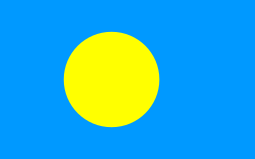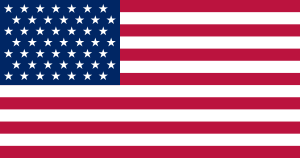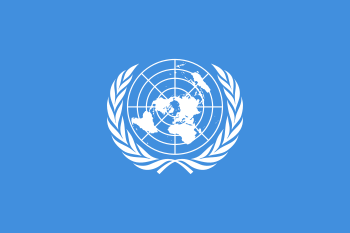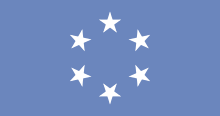Flag of Palau
The flag of Palau was adopted on 1 January 1981, when the island group separated from the United Nations Trust Territory. As with the flags of several other Pacific island groups, blue is the colour used to represent the ocean and the nation's place within it. While this puts Palau in common with the Federated States of Micronesia and other neighboring island groups, the disc on the flag (similar to that on Japan's flag) is off-centre like that of the flag of Bangladesh, but in this case represents the moon instead of the sun. The current flag was introduced in 1981 when Palau became a republic.
 | |
| Use | Civil and state flag, civil and state ensign |
|---|---|
| Proportion | 5:8 |
| Adopted | 1 January 1981 |
| Design | A light blue field with the large yellow disk shifted slightly to the hoist-side of center. |
| Designed by | Blau J. Skebong |
Previously, the flag of the Trust Territory of the Pacific Islands was flown jointly with the United Nations and American flags. The flag's very simple design belies the depth of meaning attributed to it. The explanation for the choice of colours is rooted in the history and customs of the Palauan people. The bright blue of the field symbolizes the Pacific Ocean, and also represents the transition from foreign domination to self-government.[1] The golden disk, which sits slightly off-centre toward the hoist, represents the full moon. The Palauans consider the full moon to be the optimum time for human activity. At this time of the month, celebrations, fishing, sowing, harvesting, tree-felling, and the carving of traditional canoes are carried out. The moon is a symbol of peace, love, and tranquility.
Japanese international relations professor Futaranosuke Nagoshi has suggested that the Palauan flag pays tribute to the Rising Sun Flag of Japan and symbolizes amity between Palau and Japan.[2] Former Palauan President Kuniwo Nakamura responded to this theory in an interview with the ambiguous statement, "That's one way of putting it."[3] John Blau Skebong, the designer of the flag, denied such allegation, saying there is no special connection between the two flags.[4]
Construction
.svg.png)
The construction of the flag is described on the Palauan government website.[5]
Historical flags
.svg.png) Flag of Spain, which owned Palau until 1899 as part of the Spanish East Indies
Flag of Spain, which owned Palau until 1899 as part of the Spanish East Indies.svg.png) Flag of the German Colonial Empire, used in some of Palau from 1885, and all of Palau 1899–1914
Flag of the German Colonial Empire, used in some of Palau from 1885, and all of Palau 1899–1914.svg.png) Flag of Japan, used in Palau 1914–1944
Flag of Japan, used in Palau 1914–1944.svg.png) This flag of the United States was used in Palau from 1944–1959
This flag of the United States was used in Palau from 1944–1959 This flag of the United States was used in Palau from 1959–1960
This flag of the United States was used in Palau from 1959–1960.svg.png) This flag of the United States was used in Palau from 1960–1994
This flag of the United States was used in Palau from 1960–1994 The flag of the United Nations was used in Palau from 1947–1965
The flag of the United Nations was used in Palau from 1947–1965 Flag of the Trust Territory of the Pacific Islands was used in ROP 1965–1981
Flag of the Trust Territory of the Pacific Islands was used in ROP 1965–1981
References
- Republic of Palau Convention History of the National Flag
- Futaranosuke Nagoshi (1987) 世界に生きる日本の心(Sekai ni ikiru nihon no kokoro, Japanese spirits being around the world). Tendensha.
- Reizō Utagawa (December 1999). "Travels in Republic of Palau". The financial world (in Japanese). Zaikai Kenkyujo. Archived from the original on 3 May 2009. Retrieved 3 May 2009.
- "パラオ国旗の作者との対話". 26 October 2010.
- "Flag – PalauGov.pw". Retrieved 23 April 2020.